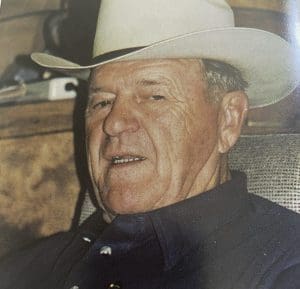By Betty Jo Gigot Publisher

In November 1996, the CALF News Cattle History series featured Ed Barrett, a cattle feeder who started his career in Kansas and then moved to Texas. The Barrett and Crofoot organization became an important part of cattle feeding history in the Hereford, Texas, area.
The CALF News article started with Barrett thinking back on his early life:
Ed Barrett leans back in his chair, pushes back the ever-present Stetson and smiles. “All my life, I have had two idols – E.C. Crofoot and John Wayne … and of course, my wife, Millie.”
In those early days, at the age of 11, Barrett, had another hero, Jim Lowder, a well-known cattleman in the Emporia, Kan., area. Lowder invited Barrett to sit with him during a movie at the Strand Theater.
“Lowder had a good-looking hat and nice-looking pants, and there I was in overalls. To think that Jim Lowder would let me sit down beside him probably encouraged me to want to be in the cattle business.”
At 14, Barrett was working summers at a ranch and, by that time, being in the cattle business was already under his skin. After quitting high school and jobs like climbing poles for the electric company and working construction, he was back in the cattle business. He was earning $100 a month feeding cattle with a pitchfork, a shovel and a team of horses.
“My job was to feed 700 to 800 cattle by hand and, on Sunday, when the manager didn’t show up, I fed all 1,500 of them. At that time, you didn’t think anything of it. It was just part of the job.”
He went on to work in a packinghouse, which added to his education, and worked as a candy and tobacco salesman for a merchant supply house. “If you believe in something, you can sell anything you want to.”
Eventually, Jim Lowder built Cattlemen’s Feedlot in the Emporia area, and Barrett was hired as assistant manager for the 5,000-head yard, making $450 a month plus $50 for using his own pickup.
Meanwhile, Barrett had put together quite an education. “Everywhere I worked, I learned something that helped me later. I learned about construction, how to feed cattle and how to sell. At the processing plant, I learned about beef. It all fit together. I had already learned to work hard. I learned that from my dad.
“One of the best things that ever happened to me is that I married a good woman,” Barrett said at the beginning of the interview. “Millie and I have been married since 1951. It is a good life when you live with a good wife.”
“All my life, I have had two idols – E.C. Crofoot and John Wayne … and of course, my wife, Millie.” – Ed Barrett
The late ‘60s were a bit of an adventure for Barrett when E.C. Crowfoot and Earl Brookover bought a feedyard in Texas. They offered Barrett a job and he took it for a year. Then he went back to Kansas to fulfill another dream – to build his own feedyard.
Called a six-month wonder, Barrett and Ron Hughes started building Flint Hills in January 1969 with a $275,000 SBA loan and, as he says, a good idea. They opened the yard 12 days late on their projected schedule of six months. It became a very successful venture.
1974, as anyone in the industry remembers, was a turning point for many in the business, and Barrett, after running Flint Hills through the years, took another trip down to Texas just for fun. “At the time it was just something to do,” Barrett said. “A free trip.”
After studying the feeding industry decimated by the ’74 crash, he saw opportunity. “I called Mr. Crofoot and said, ‘These people down here are so sick, they’re not sure they ever want to feed cattle again.’”
Crowfoot told him that if he wanted to come on down, they could buy a feedyard. They went 50/50 and the Barrett/Crowfoot saga began, and continues today.
Editor’s Note: It was my pleasure to present the Cattle Feeders Hall of Fame (CFHOF) Award to Millie Barrett and their son, Bob, at the CFHOF Banquet this year as we all remembered one of our heroes … Ed Barrett.






